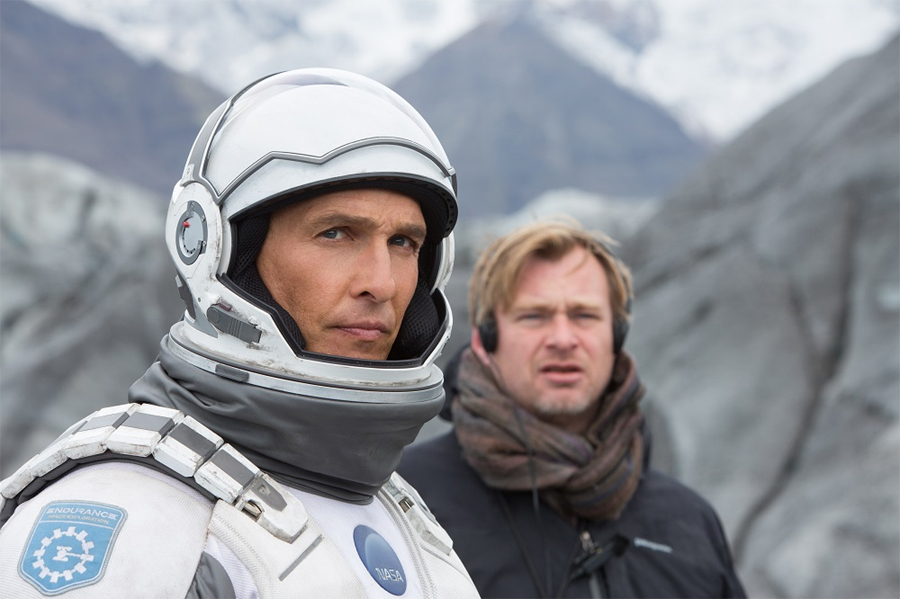
Perhaps the best way to understand Christopher Nolan as an artist is to compare him to another sovereign of a separate craft: Taylor Swift. Before scoffing, give it some thought: Both have rabid fan bases that can put out positivity one moment and malicious attacks the next (Swifties adore Twitter, while Nolanites take to IMDb message boards to spout vitriol at cynics). Both are paragons of their respective fields: Swift’s new pop opus, 1989, went platinum in a week, and Nolan’s latest big-budget odyssey, Interstellar, will most likely end up as the highest-grossing original film of the year – he is the only non-Spielberg entity who inspires confidence from studios and audiences alike. Possibly the clearest correlation comes with the expectations pegged to each of their backs whenever a new undertaking is announced. A Swift album without a breakup song would be like a Nolan film laden with digital effects. But that’s where the similarities end. While Swift finds a safe haven from the Haters she sings of in corners of the internet, Interstellar (which, coincidentally, hit theatres just as 1989 graced shelves) has been subject to quite a bit of unfair harassment, particularly on the web.
The privilege of writing for a biweekly publication is being able to assess others’ reaction to any certain work. When Nolan revealed Interstellar to critics a little over three weeks ago, advance word predictably started to seep through his usual veil of secrecy – this is usually the case.
Additionally unsurprising was how quickly tweeted reactions and online reviews gave way to critiques of Interstellar’s scientific accuracy written by movie bloggers, and attacks on its storytelling by scientists. “The overall plot isn’t bad,” wrote astronomer Phil Plait on Slate, also mentioning “leaden dialogue, obvious foreshadowing, and a…misguided attempt to be deep” before finally launching into his “takedown” of its science. (Days later, Plait, who has no discernible history in film criticism, ran a follow-up entitled “Interstellar Mea Culpa,” in which he rescinded almost every point made in the original piece) All of this is not to mention the countless “15 Maddening Plotholes” or “When You Should Take Your Bathroom Breaks” features run by Entertainment Weekly and Vulture, respectively.
These negative pieces all stem from complaints in two areas: science and sentiment. With famed physicist Kip Thorne onboard since Spielberg was himself attached to direct, one would’ve thought his peers would keep from criticizing Interstellar, but as the Slate piece makes abundantly clear, not even the minutest imprecisions in the name of narrative are sacred.
As for the subject of love, arguably the core theme of the story, bloggers were quick to dismiss it as a “cheesy” throughline that got in the way of spectacle. An online review that labeled Interstellar “too ambitious” chalked that overshooting up to its emotional nature, implying that there simply wasn’t enough room for it. Often chided for a perceived lack of emotion, Nolan was suddenly being chastised for directly responding to that exact condemnation.
But what of the work itself amidst such snark? What of Nolan’s classical dedication to shooting and projecting his movies on physical film, the first major post-Oscar film appearances from stars Matthew McConaughey and Anne Hathaway, or the film’s place amongst other pro-science epics? Must we hold it to an unreasonably high standard of reality due to its endorsement of knowledge and exploration, and does Thorne’s involvement at every stage of production not guarantee a certain level of factual accuracy? And, most importantly, did the internet collectively ramp up its cynicism simply because it is uncomfortable with Nolan’s apparent switch to sentimentality as he tackles love instead of evil, as he did with the Dark Knight trilogy?
I ask these questions not because I can answer them, but because I believe doing so is far more crucial than pinpointing the exact moment I should empty my bladder during Interstellar. This is the last I’ll say regarding its science, because the “B” I received from Mr. Meyers in physics was a generous but inaccurate judgment of my comprehension of the topic: Thorne’s near-complete lack of grievances with Nolan’s adherence to the laws of physics should speak for itself. Interstellar is not a docudrama. It is a major work drawn from an incredibly assured vision, one that affected me on a unique level.
Interstellar does not begin in space. Nolan, rewriting his brother Jonathan’s draft, sets the first act on rural North American farmland on an environmentally corrupted Earth, where ex-NASA pilot Cooper (McConaughey) lives with his Father-in-Law and two children. A scientific anomaly discovered by his daughter, Murph (Mackenzie Foy) leads the duo to Cooper’s former employers, who promptly recruit him to lead a desperate mission through a newly discovered wormhole in order to find a planet more capable of sustaining life than the one we’ve ruined.
That’s the most anyone should know entering the movie. Nolan keeps secrets for a reason – a progenitor of the theatrical experience, he has indicated that he wants audiences going in as “dark” as possible. As the film unspools, the turns it takes are not predictable or entirely surprising, keeping our attention trained on Cooper and his travel companions (Wes Bentley, David Gyasi, and Hathaway, all solid) as well as the powerful parent-child bond set up in the first few sequences.
McConaughey is aces, displaying the same level of intensity he has brought to all of his projects for the last two years. Cooper is certainly a stubborn guy, but as played by Everyone’s Favorite Texan, he also becomes a misty-eyed father conflicted by his obligations to mankind and his family. He and Foy nail his departure scene, setting a melancholy tone that Cooper carries on his journey.
Nolan doesn’t fetishize Middle America as Zack Snyder and JJ Abrams have with the Rural Sci-Fi trope (in Man of Steel and Star Trek), nor does he romanticize it like Terrence Malick (though the latter holds an influence on how he shoots dust storms and corn fields). The story’s relationship to its surroundings here is much more akin to something like Rian Johnson’s Looper as the environment is intrinsic to the narrative – the cornfields Cooper reluctantly harvests for a living are this America’s last sustainable crop.
As the film moves into space, however, he embraces its ominous beauty, and, thankfully, its silence. A lack of CGI, as well as his method of shooting spaceships as he does cars, with mounted, stable IMAX cameras, makes Interstellar the Anti-Gravity. Recently accused of having a “lack of wonder,” Nolan simply lets the inherent beauty of the clear, stunningly large images (especially when viewed on an IMAX screen) speak for itself.
Cinematographer Hoyte Van Hoytema, a Nolan first-timer amongst a crew of usuals, creates a diverse and coherent color palette that feels realistic and innovative at the same time – the scene in which McConaughey & Co. pass through the wormhole feels as real as anything that can be seen onscreen right now. Elsewhere on the technical spectrum, frequent associate Hans Zimmer has delivered one of his finest scores, dense but subtle in times of awe and passionately bombastic when characters are confronted with grave emotions. Two specific moments on either end of the film are accentuated by quick organ swells so bold I was left shellshocked.
As is Nolan’s primary fault, Interstellar can occasionally trip over itself with bouts of exposition that over-explain its scientific “rules” instead of simply showing them to us and leaving it at that. Hathaway in particular is saddled with one or two too many explanatory chunks that are not mandated by the story and feel unnatural coming from her. This may not even be Nolan’s fault. It’s entirely possible that such exposition was studio intervention, collateral for allowing him to make a $160 million event movie with strong female characters and a lack of pornographic 9/11-esque “action.” Interstellar feels like an abnormally adventurous film, exposition and all.
Ragging on Interstellar because you’re fundamentally opposed to its blend of science-based action and formidable sensitive streak is understandable – some people, myself excluded, may find one gets in the way of the other. But quantifying its celestial ambition as “too much” is irresponsible on the part of anyone with influence. Flaws included, it is the Taylor Swift of 2014 cinema – an optimistic blip in a pessimistic field, not the movie we deserve, but possibly the one we need right now.









